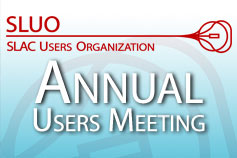

Wednesday - July 23, 2008
SLAC Today is
available online at:
http://today.slac.stanford.edu
In this issue:
SLUO Annual Meeting: SLUO2008
People Today: Peace Esonwune
Conservation Tip of the Week: Light Up My Life
 |
 |
|
Wednesday - July 23, 2008 |
 SLUO Annual Meeting: SLUO2008On September 18th, the SLAC Users Organization (SLUO) will convene its Annual Meeting. The meeting will be held in the Kavli Auditorium from 8:00 a.m. until 6:30 p.m., followed by a reception in the Breezeway. The SLUO Annual Meeting is an invaluable opportunity to learn about the latest plans, new developments and science opportunities in the Particle Physics and Astrophysics (PPA) Directorate at SLAC. It is also a great time to learn about new projects and to interact with other members and potential new colleagues, to discuss the future collaborations between SLAC and the university physics community. Like the laboratory and the whole field, SLUO is making a major transition this year: after years of supporting users at on-site accelerator-based facilities, the organization now needs to better understand how to represent the research interests of a potentially much broader community of members. It is imperative that we succeed in re-inventing SLUO, in order to contribute to insuring a strong future of excellence in our field! Read more... |
||
|
|
||

Peace Esonwune
Peace Esonwune has a busy schedule. Between pursuing a graduate degree, taking care of her two children and doing research at the Stanford Synchrotron Radiation Laboratory (SSRL) as a Graduate Degrees for Minorities in Engineering and Science (GEM) Fellowship Summer Intern, she also makes time to volunteer as a mentor for young people. "No matter how busy I am, I try to prioritize that," she says. "I've mentored students who say school is not for them. They're just barely making it in high school. With a mentor you see them finish high school, go to college, do something with their lives. It's very inspiring." Esonwune volunteers as a science and math tutor for high school students, and in her children's science and math classes. She says that with a mentor in her own life, she might have navigated the American educational system better upon her arrival in the U.S. Esonwune immigrated from Nigeria in 1996, when she was almost finished with her undergraduate studies. But it wasn't until many years later that she pursued and completed an undergraduate degree, a Bachelor of Science in electrical engineering and computer science from U.C. Berkeley. "It is important for recent immigrants to be mentored, so they can get into school and complete their education in order to thrive while in the U.S. and in life," she says. Read more... |
Conservation Tip
|
Events
Access (see all)
Announcements
|
| | ||
|
|
||
 <%
Response.AddHeader "Last-modified", getArticleDate()
'Response.AddHeader "Last-modified","Mon, 01 Sep 1997 01:03:33 GMT"
'Monday, December 06, 2010
%>
<%
Response.AddHeader "Last-modified", getArticleDate()
'Response.AddHeader "Last-modified","Mon, 01 Sep 1997 01:03:33 GMT"
'Monday, December 06, 2010
%>View online at http://today.slac.stanford.edu/. |
||